Continued from page 1
Sustainability Advantages
FL: Many architects for example will pay attention to energy performance when it is time to submit for permitting. They’ll run ResCheck or ComCheck and then find out they need to add more insulation or have a higher performing window system or whatnot. At this point you are making changes so late in the design process that the improvements you can make towards energy performance are pretty minimal.
You aren’t going to reconfigure major formal changes to a building or re-site the building when you are 95 percent through working drawings. That’s just not going to happen. But from my experience with BIM, for all of its benefits as a production environment, it also had the potential to help designers design better performing buildings earlier in the process by helping them test and validate qualitative design assumptions. So rather than just throw up a set of windows for compositional reasons–which is nevertheless important–why not actually be able to test out questions like “do I have the appropriate amount of glass on this elevation or not?”
So the book is oriented towards moving the mindset about BIM from the big office with big projects to the smaller office with smaller projects and also about rethinking the values of BIM in the earlier stages of the design process.
AFR: That was a very lucid explanation and I am sure our readers will appreciate that. I would agree with you. I want to drill down into this further because this is what makes your book unique.
FL: Okay.
AFR: This book to my knowledge is one of the first books about BIM that addresses specifically the small-firm office. And you have been explaining the rational about that. But I am wondering if you can add a little bit more color to the discussion, about this book, for small firms…how it may or may not differ from the information out there about BIM which tends to be for larger firms.
FL: Sure. Deep thinkers about BIM will point to interoperability as being one of the cornerstone’s of BIM’s power and importance. And for this point I’ll just shorthand that by alluding to bigBIM, littleBIM. And I think that is fine; and it is certainly true that even small firms need to collaborate. But frankly, while it is important, it is not as high a priority to a small firm as it is to a large firm.
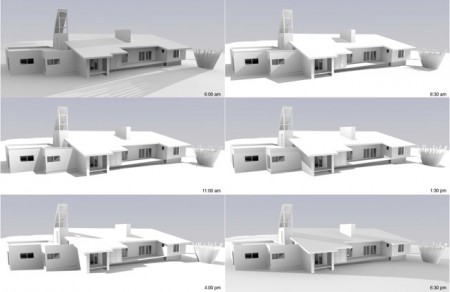
02 - Building geometry and sun studies are very commonly utilized from Building Information Models. This one shows studies at different times of the day. Further studies combine this matrix of decisions with internal daylighting and energy. (image courtesy: Francois Levy, AIA)
And for example, if you go the AIA Convention and you walk past one of the BIM software providers you will typically see BIM employed for large projects. And for small firm owners like myself seeing that you can say to yourself, “well, I’m never going to do an airport, so I can just walk on by and go check out the Pella Window guys or something.”
So the areas where the BIM discussion is happening just misses the small firm entirely. That’s one issue that I address in my BIM book. Another that this book addresses that to my knowledge none of the others address is the fact that the smaller the project the more susceptible to climate it is. So once again the more critical BIM is to help architects in smaller practices design to climate.
AFR: Right and you summarize this in the opening pages of your book. So I want the reader to fully understand what you are saying so I’m going to ask this somewhat rhetorical question. Are you saying that smaller buildings are more important to climate then larger ones?
FL: No, what I am saying is that if you are designing a 2 million square foot building the most important loads on energy consumption are going to be generated by people and equipment–they will have a very large impact on the energy load footprint of the structure. Whereas if you are doing a 2000 square foot structure how your building performs is largely going to be determined by its relationship to climate.
AFR: Right. In your book you say that smaller structures are “skin-load dominated” rather than “internally-load dominated” and therefore their morphology is more impacted by climate. So in general, the smaller the building the more susceptible it is to the impact of climate on the building?
FL: Correct.
AFR: Okay. So your book definitely gets into a range of topics such as passive cooling, passive heating, solar geometry and daylighting and onsite energy systems–all topics you might find in an environmental building design book not a book about BIM adoption. Is that one of the unique features of your book, not only is it addressing BIM and the small practice but it is addressing the issue of scale and its relation to climate and energy consumption?
FL: That is exactly right and I don’t know of any books that do that. And of course someone who is deeply interested and versed in sustainability may find this book lacking in detailed knowledge of sustainability; likewise someone who is deeply versed in BIM topics may find this book lacking in BIM technical issues. But this book is both. Which again goes back to the importance of small buildings to climate; those small buildings constitute about 20 percent of our national energy footprint.
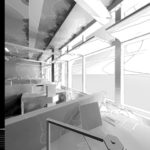
03 - Performed in Radiance, this isolux contour analysis shows the benefits of reflective shading devices.
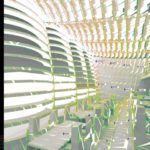
04 - A forced-color illuminance analysis in Radiance. Note the lux values noted throughout the space. With BIM models solar geometry and daylighting simulations are very valuable. (image courtesy of: Adam Pyrek)
AFR: Some might say that’s a collective 20 percent.
FL: It is. As an individual architect practicing on small buildings I’m going to have a token impact on our nation’s national energy footprint, but as a representative of a large swath of our industry–architects in small practice doing residential and small commercial–we can have a massive impact on our energy consumption.
AFR: It will take breaking down a certain mentality. The result of which is that as a collective small-firm practices can have a massive impact on our national energy footprint.
FL: Absolutely. That is perhaps the larger and better reason for the adoption of BIM in the small building practice.
AFR: Then why not legislate this, why not require it in law? Big BIM is doing BIM for many other reasons and a good by-product is greener design. But there are so many small firms and this group is lagging. This just means lost energy potential. What are your thoughts on this?
FL: How would you enforce a BIM requirement? I just don’t see it the next five years.

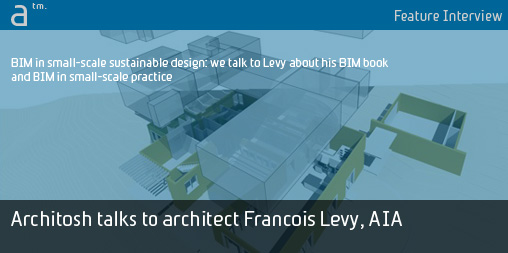
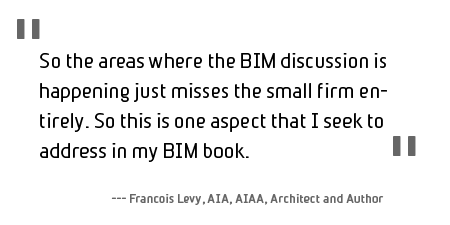


Reader Comments
Comments for this story are closed